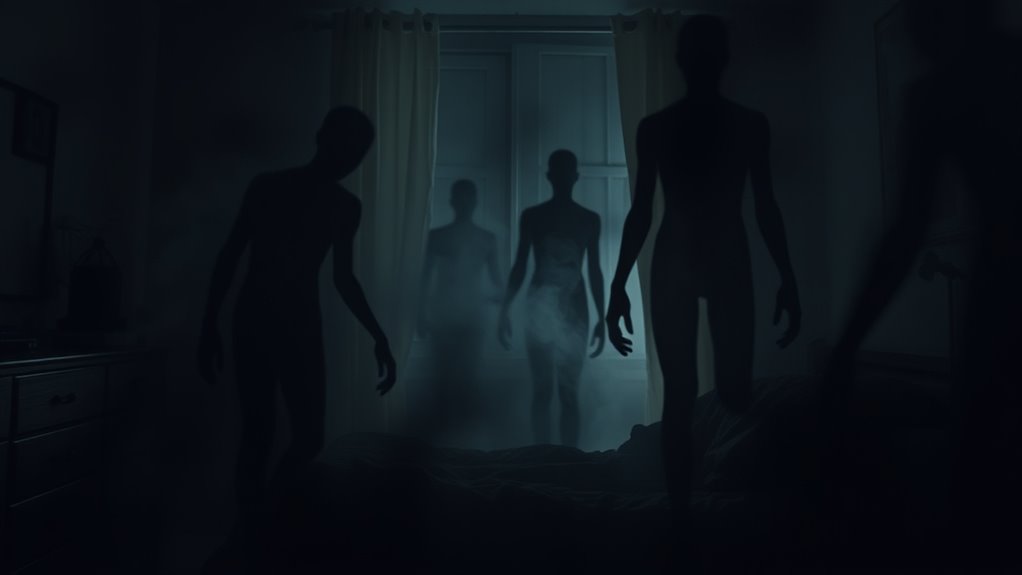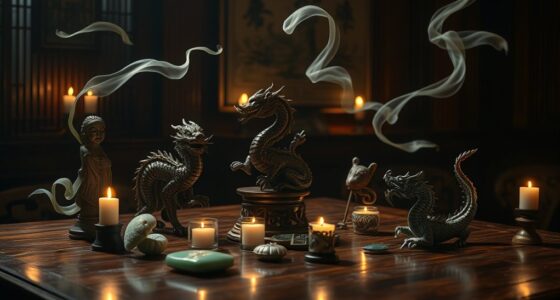Shadow people and sleep paralysis demons share common origins rooted in how your brain processes fear, subconscious imagery, and altered states of consciousness. During sleep paralysis, your mind creates vivid hallucinations, often influenced by cultural symbols or personal fears, which can appear as shadowy figures or malevolent entities. These experiences reflect unconscious mental processes working in tandem with neurobiological factors. Exploring this connection offers fascinating insights into how your mind interprets the unknown — and you’ll discover more as you look deeper.
Key Takeaways
- Both phenomena originate from the brain’s interpretation of subconscious fears and fragmented sensory input during altered states like sleep paralysis.
- Cultural myths and archetypes influence how shadow figures and demons are perceived, reflecting shared symbolic meanings across societies.
- Neurobiological mechanisms, such as neurotransmitter imbalances and brainstem activity, produce vivid hallucinations common to both experiences.
- They represent unconscious conflicts and fears projected into visual imagery during sleep disruptions and altered consciousness.
- Universally, they embody archetypal symbols of helplessness, evil, or spiritual guides, indicating a common psychological and cultural origin.
The Cultural Roots of Shadowy Figures

Throughout history, cultures around the world have created stories and symbols to explain mysterious shadowy figures that appear during sleep paralysis episodes. These figures often embody fears or spiritual beliefs, serving as a form of historical symbolism. Artistic representations across civilizations depict these shadowy beings as demons, spirits, or malevolent entities, reflecting societal fears and explanations for the unknown. In ancient folklore, they symbolize evil spirits or ancestral spirits warning the living. Through paintings, carvings, and myths, societies have visually encoded these encounters, giving them meaning and context. These cultural expressions reveal a universal attempt to understand and confront the unsettling presence of shadow figures during sleep paralysis, emphasizing their deep-rooted significance across time and cultures.
Common Features of Sleep Paralysis Entities
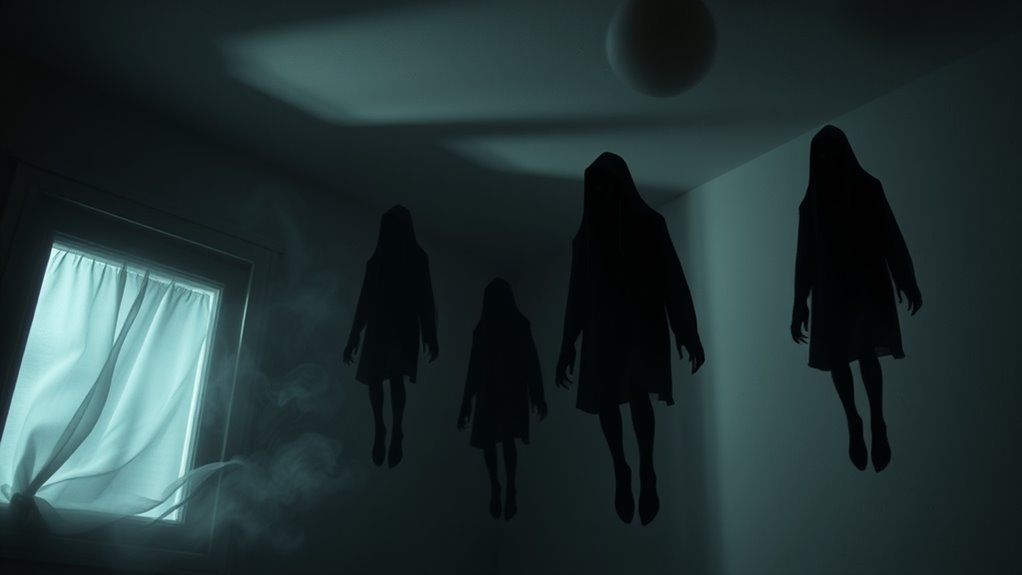
Sleep paralysis entities often share striking visual and experiential features that make them universally recognizable. You might see shadowy figures, often described as human-like forms, lurking at the edge of your vision. These beings frequently appear during transitions in your sleep cycle, especially when you’re close to waking from a vivid, often lucid dreaming state. Their features tend to include:
- Dark, featureless silhouettes or shadow people
- Sudden, intense feelings of dread or pressure
- Movements that seem involuntary or jerky
- An overwhelming sense of presence or malevolence
- Inability to speak or move, heightening terror
These common traits suggest a link to your sleep cycle, where vivid dreams and hallucinations become intertwined with sleep paralysis. Their consistent appearances point to shared neurological or psychological mechanisms at play.
The Psychological Perspective: Hallucinations and Dreams
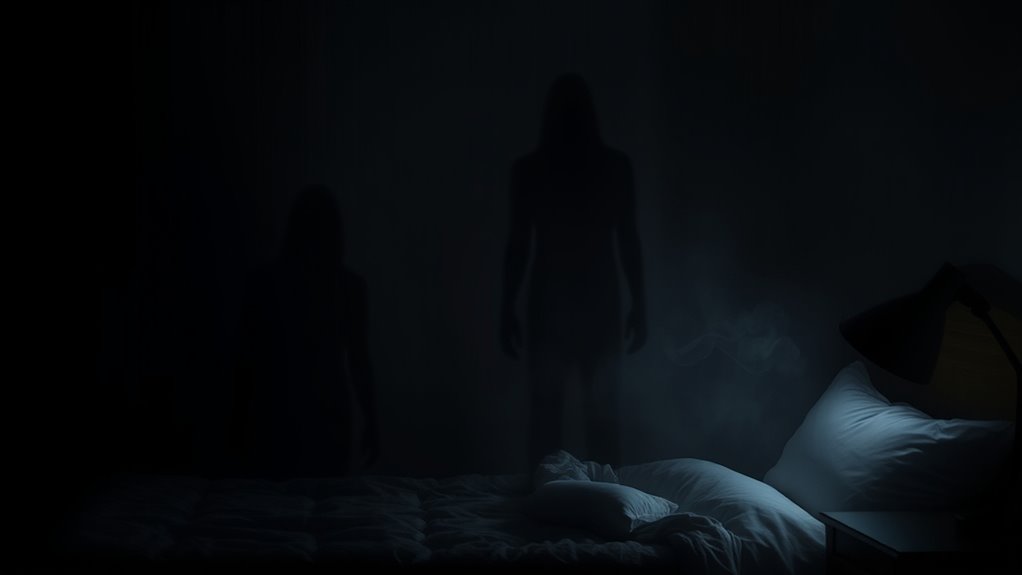
Your mind can create vivid hallucinations during dreams or sleep paralysis, blurring the line between reality and imagination. Certain triggers, like stress or sleep disruptions, increase the likelihood of experiencing these phenomena. You might notice unusual visual perceptions, such as shadowy figures or distortions, that reflect your brain’s attempts to interpret fragmented sensory input.
Dream State Hallucinations
Dream state hallucinations often blur the line between reality and imagination, creating vivid images and sensations that feel entirely real. During this time, your mind actively constructs scenes, sometimes influenced by your subconscious or external stimuli. Lucid dreaming, where you’re aware you’re dreaming, exemplifies how hallucinations can be manipulated within the sleep cycle, allowing you to explore or alter these visions consciously. These hallucinations occur naturally during rapid eye movement (REM) sleep or progression states, highlighting the brain’s active role in dreaming. Factors like stress, fatigue, or sleep deprivation can intensify these experiences. Understanding how hallucinations fit into your sleep cycle helps demystify their origins and reveals their connection to the mind’s creative and perceptual processes during rest.
- Brain’s visual processing during REM sleep
- Influence of subconscious fears and desires
- Role of neurotransmitters in hallucination formation
- Connection between lucid dreaming and hallucination control
- Impact of sleep stages on hallucination vividness
Sleep Paralysis Triggers
Psychological factors such as stress, anxiety, and nightmares can considerably trigger sleep paralysis episodes, often accompanied by vivid hallucinations. Poor sleep hygiene increases the likelihood of these episodes, so maintaining consistent sleep routines helps reduce risk. Managing stress through relaxation techniques can lessen hallucination intensity. Dream journaling is also helpful; recording your dreams and nightmares can reveal patterns and emotional triggers that contribute to sleep paralysis. By understanding your sleep and dream patterns, you can implement strategies to improve sleep quality and reduce episodes. Avoiding irregular sleep schedules and creating a calming bedtime environment are essential. These psychological approaches help regulate your sleep cycle, making hallucinations less frequent and intense, and fostering a healthier, more restful sleep experience.
Visual Perception Anomalies
Sleep paralysis often brings vivid hallucinations that distort visual perception, blurring the line between reality and imagination. These perceptual distortions can manifest as shadowy figures, strange shapes, or flickering lights, often creating unsettling visual illusions. Your brain struggles to interpret ambiguous stimuli, leading to intense visual experiences that feel real. Factors like heightened stress, sleep deprivation, or neurological activity influence these anomalies. You might notice:
- Unclear or shifting images
- Illusory movements or flickers
- Distorted sizes or shapes
- Shadows that seem to morph
- Overlapping or doubled visuals
These phenomena showcase how your mind’s interpretation of sensory input can be skewed during sleep paralysis, revealing the complex link between perception, dreams, and hallucinations. Understanding these visual perception anomalies helps demystify the shared origins of shadow people and sleep paralysis demons.
Neurobiological Explanations for Shadow Encounters
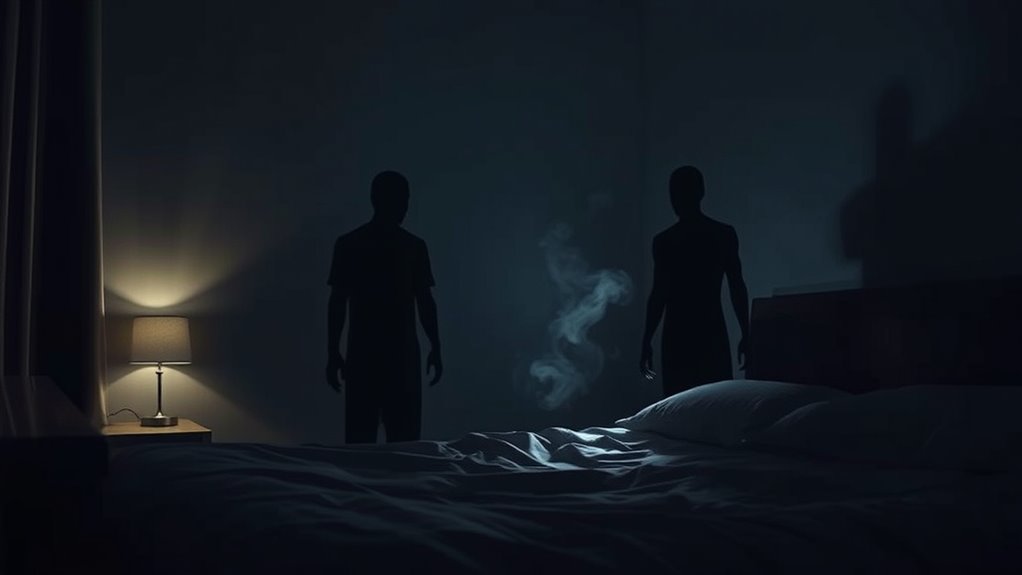
Neurobiological research suggests that shadow encounters and sleep paralysis demons may stem from specific brain mechanisms that become dysregulated during disrupted sleep states. Neurotransmitter imbalances, particularly in serotonin and dopamine, can alter sensory processing and perception, making you more prone to hallucinations. Additionally, brainstem activity plays a pivotal role in regulating REM sleep and muscle atonia. When this activity malfunctions, you might experience paralysis combined with vivid, often frightening hallucinations of shadowy figures. These mechanisms disturb normal brain functions, creating the perception of sinister entities during sleep paralysis episodes. Understanding how neurotransmitter imbalances and brainstem dysfunction contribute to these experiences helps explain their neurobiological roots, highlighting how your brain’s chemistry and control systems can inadvertently produce these haunting encounters.
Cross-Cultural Interpretations of Sleep Demons
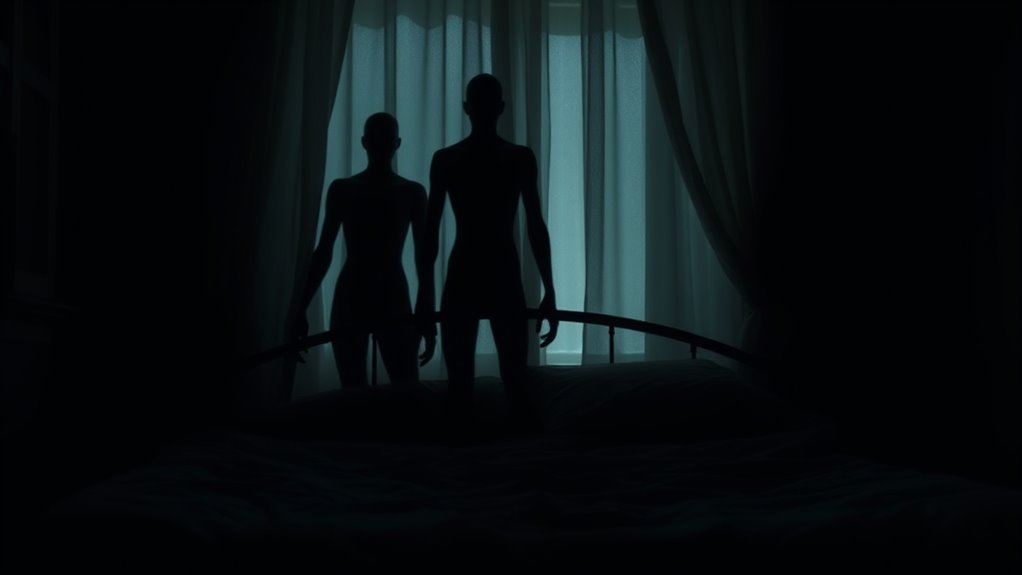
Across cultures, encounters with sleep demons vary in appearance and meaning, reflecting diverse beliefs and fears. Despite differences, many cultures describe these entities with demonic features, symbolizing danger or spiritual imbalance. Rituals and beliefs around these figures often aim to protect or banish them, highlighting shared human responses to sleep paralysis.
Cultural Variations in Encounters
Throughout different cultures, encounters with shadow figures and sleep paralysis demons are interpreted through diverse lenses that reflect local beliefs and mythologies. You might see these experiences as malevolent spirits, ancestral warnings, or spiritual tests. Many cultures incorporate meditative practices to confront these entities, aiming to transform fear into understanding. Artistic representations often depict these encounters, shaping collective perceptions and spiritual narratives.
- Some traditions view these figures as ancestral spirits or protectors.
- Others interpret them as malevolent demons or evil presences.
- Cultural storytelling weaves these encounters into moral lessons or warnings.
- Rituals and meditative practices are used to dispel or communicate with these visions.
- Artistic representations serve as tools for understanding and integrating these experiences into cultural identity.
Common Demonic Features Across Cultures
Despite cultural differences, many sleep paralysis demons share strikingly similar features that evoke fear and awe. In medieval folklore, these entities often resemble mythological beasts—creatures with sharp claws, glowing eyes, and intimidating forms designed to inspire terror. Across cultures, they tend to appear as shadowy figures or winged monsters, emphasizing their supernatural origins. These demons commonly exhibit traits of dominance and oppression, symbolizing fears of helplessness and vulnerability during sleep. Whether seen as demons, spirits, or monsters, they often embody archetypes rooted in ancient stories and mythologies. These shared features suggest a universal perception of sleep demons as powerful, otherworldly beings meant to provoke both fear and curiosity, connecting modern experiences with historical and mythological representations.
Rituals and Beliefs Surrounding Sleep Demons
Many cultures have developed specific rituals and beliefs to explain and ward off sleep demons, reflecting their deep-seated fears and attempts at control. Ancient rituals often involve chanting or prayer to dispel malevolent spirits, while protective symbols serve as spiritual barriers. These symbols, such as amulets or talismans, are believed to repel or safeguard against sleep demons. For example, some cultures carve protective symbols into doorways or wear them as jewelry. Rituals may include burning herbs or incense to purify sleep spaces. Others invoke ancestral spirits for protection. Common practices also involve sleeping positions thought to minimize vulnerability. Overall, these rituals and symbols reveal a universal effort to control the unknown and maintain peaceful sleep.
The Role of Fear and Trauma in Manifestations

Fear and trauma often serve as powerful catalysts in the manifestation of shadow people and sleep paralysis demons. When you experience intense emotional memory or traumatic events, your mind can interpret these feelings as external threats, amplifying fear trauma. This heightened emotional state can make hallucinations more vivid and frightening. Your subconscious may project these unresolved fears into shadowy figures or demons during sleep paralysis episodes. Recognizing how emotional memory influences these encounters can help you understand their origins.
| Factor | Effect |
|---|---|
| Fear trauma | Heightens perception of threats during sleep |
| Emotional memory | Triggers vivid, often distressing hallucinations |
| Trauma-related triggers | Increase likelihood of shadow/demon appearances |
Are Shadow People and Sleep Demons Different Faces of the Same Phenomenon?
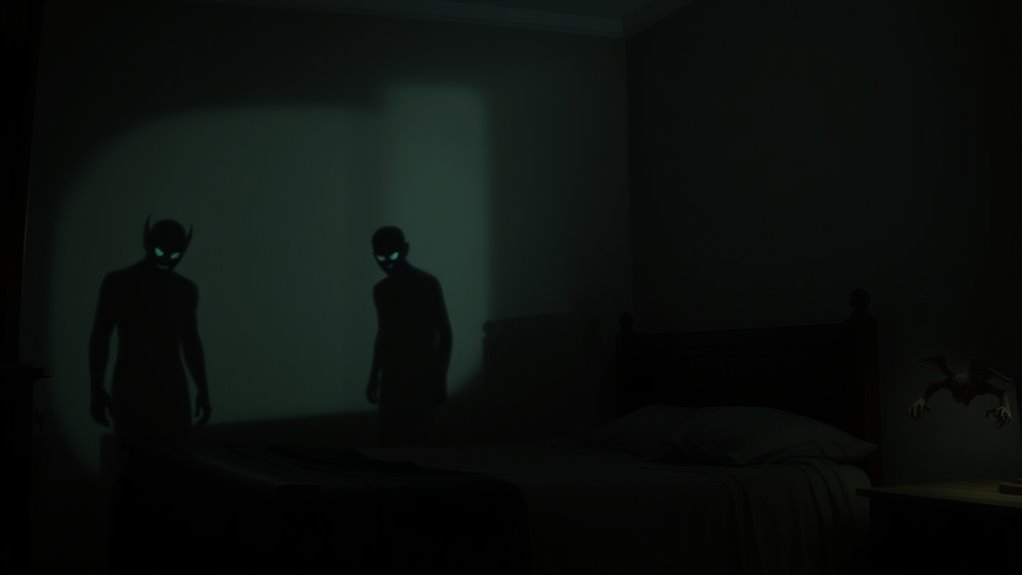
You might wonder if shadow people and sleep demons are just different versions of the same experience. Across cultures, people share similar origins and beliefs about these entities, yet they’re seen differently depending on cultural context. Exploring their similarities and differences can reveal whether they’re truly connected or just unique interpretations of a common phenomenon.
Shared Origins and Beliefs
Shadow people and sleep demons often share strikingly similar origins rooted in human psychology and cultural beliefs. Historically, misconceptions shaped how societies interpreted these phenomena, reinforcing fears and legends. Both are linked by shared symbolism, representing unknown anxieties or subconscious fears. These entities often symbolize:
- The universality of sleep paralysis experiences across cultures
- Common themes of vulnerability and helplessness
- Cultural archetypes of shadowy figures embodying fear or guilt
- The influence of folklore in shaping perceptions
- The psychological tendency to personify unexplained sensations
Understanding these shared origins shows how human minds interpret ambiguous phenomena through familiar symbols rooted in collective history. While interpretations vary culturally, the core symbolism suggests a deep-rooted psychological connection, blurring distinctions between shadow figures and sleep demons.
Distinct Cultural Interpretations
Across different cultures, interpretations of shadow people and sleep demons vary markedly, suggesting they may not be simply different faces of the same phenomenon but instead distinct entities shaped by cultural contexts. In ancient mythologies, these beings often represented spiritual guides or malevolent spirits, while in modern interpretations, they’re linked to sleep paralysis or subconscious fears. Cultural beliefs influence how you perceive these entities, shaping whether you see them as demons, spirits, or shadow figures. Understanding these differences helps you see how culture molds perceptions of unexplained phenomena.
| Culture | Typical Entity Description | Cultural Significance |
|---|---|---|
| Ancient Mythologies | Spirit guides or malevolent demons | Moral lessons or warnings |
| Modern Interpretations | Sleep paralysis hallucinations | Psychological or neurological explanations |
| Indigenous Cultures | Ancestors or spirits | Connection to spirituality |
Scientific Studies Linking Sleep Paralysis and Paranormal Sightings

Scientific research has increasingly explored the connection between sleep paralysis and reports of paranormal sightings, suggesting that these experiences may share underlying neurological mechanisms. Studies indicate that disrupted sleep cycles, such as those caused by sleep deprivation, can heighten the likelihood of vivid hallucinations. Researchers also link phenomena like lucid dreaming to sleep paralysis episodes, where the boundary between waking and dreaming blurs. These studies highlight correlations between brain activity patterns and reported shadow figures or demons. Notable findings include:
- Increased activity in the amygdala during sleep paralysis episodes
- The role of hypnagogic and hypnopompic hallucinations in paranormal experiences
- Heightened suggestibility during periods of sleep deprivation
- Overlap with sleep disorders like narcolepsy
- The influence of stress and anxiety on hallucination intensity
This evidence suggests a neurological foundation for both sleep paralysis and paranormal sightings, rather than supernatural causes.
Theories on the Origins of These Phenomena in the Human Mind
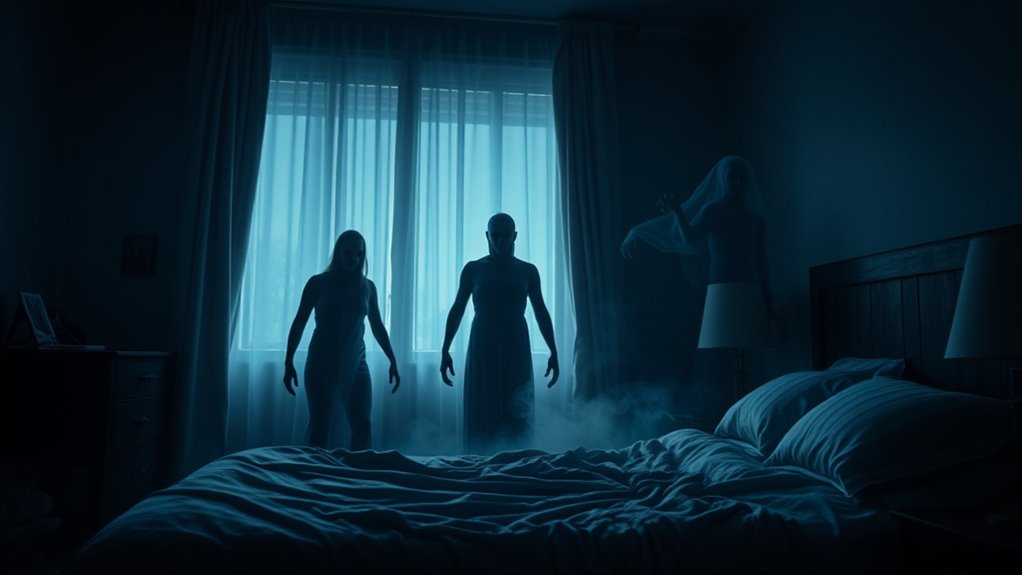
Researchers believe that the mysterious figures and demons people report during sleep paralysis stem from complex processes within the human mind rather than external supernatural forces. One theory suggests that sleep deprivation disrupts normal sleep cycles, increasing the likelihood of hallucinations and vivid imagery. When you’re sleep-deprived, your brain may misinterpret sensory signals, creating frightening figures. Another idea involves lucid dreaming, where you become aware you’re dreaming but can’t fully control the experience. During sleep paralysis, your mind might overlay dream imagery onto waking consciousness, producing shadowy figures or demons. These phenomena are likely rooted in your brain’s attempt to process fear, confusion, and sensory input during transitional sleep states, rather than evidence of external entities.
Implications for Understanding Consciousness and the Unconscious
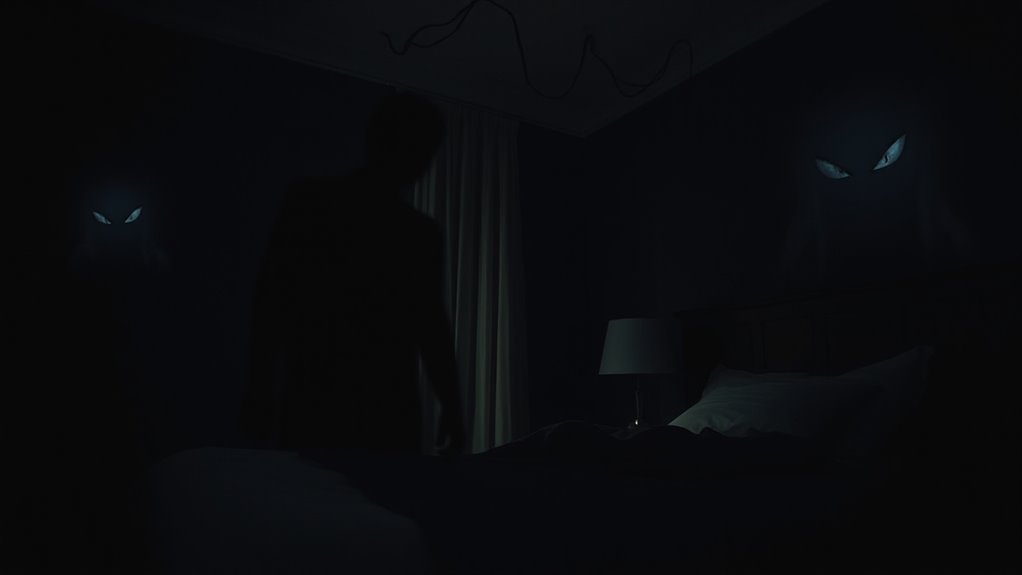
The phenomena encountered during sleep paralysis offer valuable insights into the nature of consciousness and the unconscious mind. These altered states reveal how subconscious impressions can manifest vividly, blurring the line between waking awareness and deeper mental processes. Recognizing these experiences helps you understand that your mind processes fears, memories, and expectations beneath conscious control. This awareness can reshape your perception of reality and mental health. Consider that:
Sleep paralysis reveals how subconscious fears and memories shape vivid, hidden layers of our consciousness.
- Altered states illuminate the fluid boundaries between conscious and unconscious awareness
- Shadow figures may symbolize subconscious impressions rooted in unresolved conflicts
- Sleep paralysis exposes the mind’s capacity for vivid, semi-automatic imagery
- These phenomena suggest consciousness is more dynamic and layered than everyday awareness
- Understanding these processes can foster insights into personal psychology and perception
Frequently Asked Questions
Are Shadow People and Sleep Paralysis Demons Connected Historically?
You might wonder if shadow people and sleep paralysis demons are connected historically. Cultural symbolism and mythological parallels suggest they could be rooted in similar fears and beliefs across different societies. Historically, many cultures viewed shadowy figures as spirits or supernatural entities influencing human experience. These shared themes point to a common psychological or cultural origin, indicating that such beings may represent universal symbols of the unknown, fear, or spiritual encounters throughout history.
Can Cultural Beliefs Influence the Appearance of These Entities?
Imagine your mind as a canvas painted by cultural narratives and belief systems. These influences shape how you interpret strange experiences, making entities appear more familiar or frightening. Your cultural background can alter their appearance, blending fears and legends unique to your community. So, yes, your cultural beliefs deeply influence how these entities manifest, turning universal phenomena into personalized, culturally charged encounters that reflect your shared history and collective fears.
How Do Individual Differences Affect Perceptions During Sleep Paralysis?
Your individual differences, like dream recall and sleep environment, shape how you perceive during sleep paralysis. If you often remember dreams, you’re more likely to notice vivid details or frightening figures. A stressful sleep environment can heighten anxiety, intensifying hallucinations. Your personal sensitivities and prior experiences influence whether you see shadowy figures or feel a sense of presence, making each sleep paralysis experience unique.
Are There Documented Cases Linking These Phenomena to Neurological Disorders?
You might wonder if neurological disorders are linked to these phenomena. Research shows that certain neurological conditions, like schizophrenia or Parkinson’s disease, can increase the likelihood of experiencing vivid hallucinations or sleep disturbances. Mental health issues also play a role, influencing how the brain processes sensory information during sleep. While these phenomena aren’t exclusive to disorders, documented cases suggest a connection between neurological health and such experiences.
What Are the Latest Scientific Theories Explaining These Supernatural Encounters?
You might think these encounters are purely supernatural, but science suggests otherwise. Current theories propose that phenomena like shadow figures and sleep paralysis demons could be explained by quantum entanglement and consciousness transfer. These ideas imply your mind might momentarily connect with alternate realities or transfer consciousness between dimensions. While wild-sounding, research hints that our brain’s complex quantum processes could create such vivid, otherworldly experiences during altered states of consciousness.
Conclusion
As you explore these shadowy figures and sleep demons, imagine them as whispers from the mind’s dark attic, flickering like ghostly lanterns in a foggy night. Their shared origins weave a tapestry of cultural stories, psychological shadows, and neurobiological lights. Understanding these entities is like deciphering an ancient map of your subconscious—revealing that what lurks in the darkness may simply be your mind’s way of illuminating its deepest mysteries.

